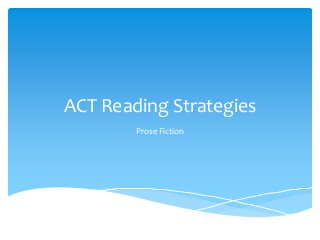
Act reading strategies_prose_section (1)
- 1. ACT Reading Strategies Prose Fiction
- 2. Prose Fiction Keep track of the characters in passage – the characters move through the narrative Pay attention to the details of the plot -- How do the characters move the plot?) What are the characters emotions? (Tip: Use emoticons to note this in the passage) What are their relationships to each other ?
- 3. Prose Fiction Tone – the author is trying to do something with the selection. The author is trying to get a certain reaction from the reader (amusement, growth in character, a struggle in the character, sadness, happiness, etc.) Dialogue – characters’ relationships to each other are revealed in the dialogue, emotions, who is saying what, how they are saying it, what emotion is shown, the author’s word choice, and the adverbs that the author’s choose to use
- 4. Prose Fiction Remember: To identify the characters To determine the attitude To find the “real” story The excerpts are from short stories and novels. Passages usually have a plot (a sequence with actions) and characters Keep track of the actions – who does what? where was it done, when was it done? why was it done?